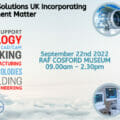In under seven years, Driven Engineering has grown from a one-man operation with just a second hand three-axis machining centre has grown into a thriving sub-contract manufacturing business on the back of founder Ray Harris’s commitment to invest in the company’s future.
Within six months of buying that first second hand machine in 2015 Ray Harris had extended his machining capacity to include five-axis capability, within a further 12 months he, still operating as a one-man business, invested in brand new Hermle machining centre, which was followed in 2019 with a further machine with a 12 position, 320 x 320 mm pallet system. Taking a short pause for consolidation, it was in 2021, in the middle of the pandemic, that he decided more space was required so a relocation to its current Havant facility took place. At the same time an order was placed for a second pallet loaded machine, this time with 50 pallets and 240 x 170 m capacity. In total the company has invested around £1.3 million in machining capacity to create a 24/7 operation, along with supporting systems such as Hypermill software to enhance productivity. Quality control is also a focus with existing measuring arms being supplemented with future investment in a CMM.
“Making the decision to relocate amidst the pandemic wasn’t ideal, but it was a positive one that needed to be taken. We completed the move in eight days ensuring minimum impact of workload and cashflow,” says Ray Harris. “At the same time we also ordered the second pallet loaded machine. The smaller pallets suit the work we do in the motorsport sector and having the multiple pallets allows for lights-out machining. We now have capacity to run for an entire weekend unmanned.”
The type of components machined by Driven Engineering lend themselves to be gripped in vices, rather than fixtures, which is where Ceratizit UK & Ireland plays its part. In addition to providing cutting tools, it has also been instrumental in kitting out the pallets with its latest ZSG4 vice system. The ZSG 4 vice has several benefits, but key to Driven Engineering is the ability to grip billets on just 3 mm of material. “Using such a small amount of material for gripping allows us to program the part using the bottom of the billet as the datum, we also get great access to machine five sides of the part. In addition, they deliver consistent grip and accuracy making them ideal for unmanned machining.”
In total Ceratizit has supplied Driven Engineering with 75 ZSG 4 centric vices, in a combination of 125 mm and 80 mm widths. Each vice is capable of applying up to 35 kN of gripping force, which allows the minimum grip depth of 3 mm. A further advantage is the lack of any requirement for billet preparation prior to gripping, unlike other systems on the market. Their suitability for pallet-based machining is enhanced by their compatibility with PNG, MNG and Lang zero point clamping systems.
Driven Engineering’s core business is in support of the motorsport sector, due in part to Ray Harris’s own racing ambitions where he has manufactured parts for a Ginetta G55 car he races in the British Endurance Championship and his own car that he competes with in the Intermarque Silhouettes championship. Outside of parts for these cars Driven Engineering was also involved in the development project for the HALO devices found on many open cockpit racing cars. These complex parts were machined using Ceratizit’s CCR, HFC and Silverline (ballnose) cutters. “We benefit from Ceratizit’s online support and face-to-face interaction in order to generate the correct cutting data, with our local technical Sales Representative, Lee Pinhorne, on-hand to support us with new projects. This is especially valuable as we diversify into other sectors of the market, and encounter materials that we haven’t machined before,” says Ray Harris. “Further support is provided by the Ceratizit tool vending system that Driven Engineering has installed. This helps to maintain production, with tools being available 24/7.”








